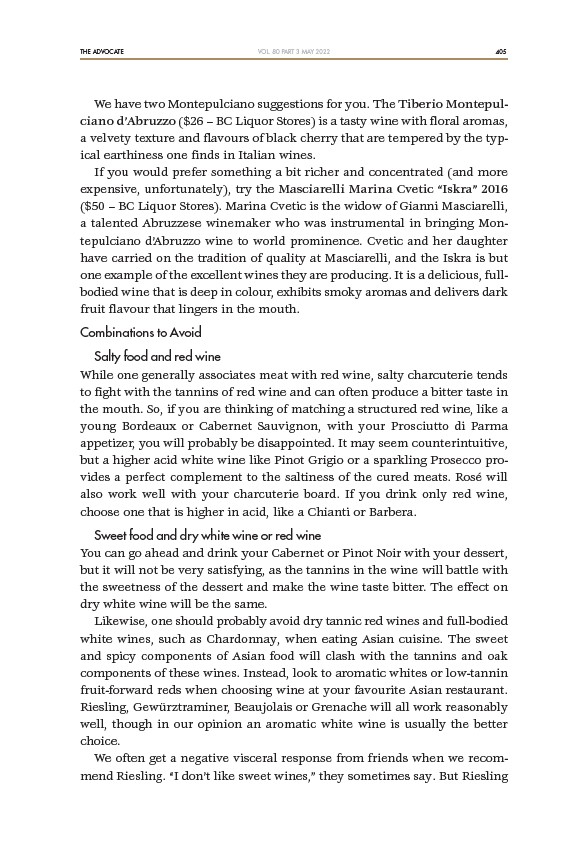
THE ADVOCATE 405
VOL. 80 PART 3 MAY 2022
We have two Montepulciano suggestions for you. The Tiberio Montepulciano
d’Abruzzo ($26 – BC Liquor Stores) is a tasty wine with floral aromas,
a velvety texture and flavours of black cherry that are tempered by the typical
earthiness one finds in Italian wines.
If you would prefer something a bit richer and concentrated (and more
expensive, unfortunately), try the Masciarelli Marina Cvetic “Iskra” 2016
($50 – BC Liquor Stores). Marina Cvetic is the widow of Gianni Masciarelli,
a talented Abruzzese winemaker who was instrumental in bringing Montepulciano
d’Abruzzo wine to world prominence. Cvetic and her daughter
have carried on the tradition of quality at Masciarelli, and the Iskra is but
one example of the excellent wines they are producing. It is a delicious, fullbodied
wine that is deep in colour, exhibits smoky aromas and delivers dark
fruit flavour that lingers in the mouth.
Combinations to Avoid
Salty food and red wine
While one generally associates meat with red wine, salty charcuterie tends
to fight with the tannins of red wine and can often produce a bitter taste in
the mouth. So, if you are thinking of matching a structured red wine, like a
young Bordeaux or Cabernet Sauvignon, with your Prosciutto di Parma
appetizer, you will probably be disappointed. It may seem counterintuitive,
but a higher acid white wine like Pinot Grigio or a sparkling Prosecco provides
a perfect complement to the saltiness of the cured meats. Rosé will
also work well with your charcuterie board. If you drink only red wine,
choose one that is higher in acid, like a Chianti or Barbera.
Sweet food and dry white wine or red wine
You can go ahead and drink your Cabernet or Pinot Noir with your dessert,
but it will not be very satisfying, as the tannins in the wine will battle with
the sweetness of the dessert and make the wine taste bitter. The effect on
dry white wine will be the same.
Likewise, one should probably avoid dry tannic red wines and full-bodied
white wines, such as Chardonnay, when eating Asian cuisine. The sweet
and spicy components of Asian food will clash with the tannins and oak
components of these wines. Instead, look to aromatic whites or low-tannin
fruit-forward reds when choosing wine at your favourite Asian restaurant.
Riesling, Gewürztraminer, Beaujolais or Grenache will all work reasonably
well, though in our opinion an aromatic white wine is usually the better
choice.
We often get a negative visceral response from friends when we recommend
Riesling. “I don’t like sweet wines,” they sometimes say. But Riesling